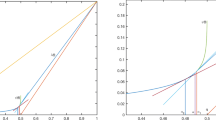Abstract
The mathematical modeling of the propagation of pollution from point sources in the air is considered. An approach that uses the idea of splitting and point-to-point computing is proposed for the numerical solution of multi-dimensional convection–diffusion equations. The construction of difference splitting schemes, approximation, and stability with respect to initial data is analyzed.
Similar content being viewed by others
References
Design Procedure for Atmospheric Concentration of Harmful Substances in Emissions of Enterprises. An All-Union Regulatory Document (OND-86) [in Russian], Gidrometeoizdat, Leningrad (1987).
Yu. A. Izrael’, Ecology and Environmental Monitoring [in Russian], Gidrometeoizdat, Leningrad (1984).
N. F. Tishchenko, Atmospheric Air Protection. Calculation of the Content of Harmful Substances and their Distribution in Air [in Russian], Khimiya, Moscow (1991).
M. Z. Zgurovsky V. V. Skopetsky, V. K. Khrushch, and N. N. Belyaev, Numerical Modeling of the Propagation of Environmental Pollutants [in Russian], Naukova Dumka, Kyiv (1997).
F. T. M. Nieuwstadt and H. van Dop (eds.), Atmospheric Turbulence and Atmospheric Pollution Modeling: A Course Held in The Hague, 21–25 September, 1981, Springer Netherlands (1982).
A. E. Aloyan, Modeling the Dynamics and Kinetics of Gas Impurities and Aerosols in the Atmosphere [in Russian], Nauka, Moscow (2008).
V. K. Arguchintsev and A. V. Arguchintseva, Models and Methods to Solve Atmosphere, Hydrosphere, and Underlying Terrain Protection Problems [in Russian], IGU, Irkutsk (2001).
G. I. Marchuk, Mathematical Modeling in the Environment Problem [in Russian], Nauka, Moscow (1982).
A. S. Grinin, N. A. Orekhov, and V. N. Novikov, Mathematical Modeling in Ecology [in Russian], YuNITI Moscow (2003).
A. E. Aloyan, V. V. Penenko, and V. V. Kozoderov, “Mahtematical modeling in the environmental problem,” in: Modern Problems of Calculus Mathematics and Mathematical Modeling [in Russian], Vol. 2, Nauka, Moscow (2005), pp. 279–351.
A. V. Gladkii, I. V. Sergienko, V. V. Skopetskii, and Yu. A. Gladka, Fundamentals of the Mathematical Modeling in Ecology [in Ukrainian], NTUU “KPI,” Kyiv (2009).
A. A. Samarskii, and P. N. Vabishchevich, Numerical Methods of the Solution of Convection–Diffusion Problems [in Russian], Editorial URSS, Moscow (2004).
A. A. Samarskii and P. N. Vabishchevich, Computational Heat Transfer [in Russian], Editorial URSS, Moscow (2003).
G. I. Marchuk, Splitting Methods [in Russian], Nauka, Moscow (1988).
A. A. Samarskii and E. S. Nikolaev, Methods to Solve Finite-Difference Equations [in Russian], Nauka, Moscow (1987).
V. K. Saul’ev, “A technique for numerical integration of diffusion equations,” DAN, 115, No. 6, 1077–1080 (1957).
Author information
Authors and Affiliations
Corresponding author
Additional information
Translated from Kibernetika i Sistemnyi Analiz, No. 4, July–August, 2014, pp. 76–88.
Rights and permissions
About this article
Cite this article
Gladky, A.V. Analysis of Splitting Algorithms in Convection–Diffusion Problems. Cybern Syst Anal 50, 548–559 (2014). https://doi.org/10.1007/s10559-014-9643-3
Received:
Published:
Issue Date:
DOI: https://doi.org/10.1007/s10559-014-9643-3



